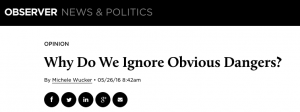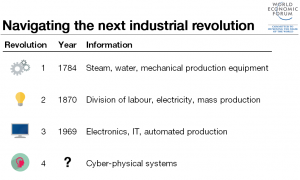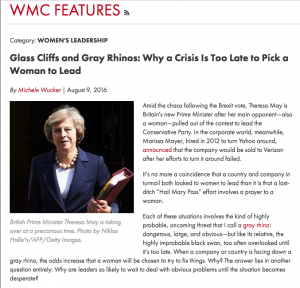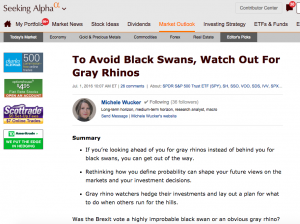Prime Minister Theresa May in Great Britain and CEO Marissa Mayer at Yahoo are two examples of women brought in to lead in extremely trying circumstances. It’s no more a coincidence that a country and company in turmoil both looked to women to lead than it is that a last-ditch “Hail Mary Pass” effort involves a prayer to a woman. But if companies and governments brought in women earlier, to both boards and leadership positions, they likely would do a much better job avoiding probable but neglected gray rhino crises. Waiting until it may be too late misses key opportunities to handle gray rhinos before they charge. Read my perspective at the Women’s Media Center.
Category: Writings
Articles and other written publications
HuffPost: Trump – RINO or Gray Rhino?
![PHOTO BY GAGE SKIDMORE. HTTPS://WWW.FLICKR.COM/PHOTOS/GAGESKIDMORE [CC BY-SA 2.0 (HTTP://CREATIVECOMMONS.ORG/LICENSES/BY-SA/2.0)], VIA WIKIMEDIA COMMONS](/wp-content/uploads/2016/07/Donald_Trump_2016-300x296.jpg)
Many of Trump’s foes within the GOP have complained that Donald Trump is a RINO (Republican in Name Only), who does not hew to conservative principles. That may be true, but he’s not just a RINO. He’s a classic example of what I call a gray rhino: a big, obvious threat that we are all too likely to neglect or outright ignore until it’s too late.
The Republican presidential candidate’s inflammatory statements and encouragement of bullying have left many Americans terrified over what’s happening to our democracy. World leaders have compared him to Hitler and Mussolini and called him everything from an idiot to a demagogue to a threat to peace.
Some pundits have described the loose-tongued business mogul’s initial popularity as an outlier black swan event, referring to Nassim Nicholas Taleb’s 2007 book about the unpredictable events that can sideswipe us. But once enough people recognize that something can happen, by definition it is no longer a black swan.
Unlike the highly improbable black swan seen only in hindsight, gray rhinos are obvious risks that all too often are poorly (if at all) addressed until they are charging straight at you. Unlike the elephant in the room, gray rhinos move fast. Crucially, they give us a choice: act or get trampled.
Trump’s campaign has tapped into an entire crash (the zoologically correct term, appropriately enough) of gray rhinos: a polarized, paralyzed government; a breakdown in democracy and civil discourse; dramatic changes in the labor market; the increasing concentration of wealth and power in the hands of the few; and, as might be expected, rising social and political unrest. Both white working-class voters and minority populations feel neglected and disrespected.
Basic civility, compromise and constructive engagement have fallen to the wayside, replaced by bullying, insults, race-baiting, and candidates comparing the size of their you-know-whats. Too many Americans feel that they lack the power to change things for the better. Some have dropped out of the political process altogether. Others are drawn, like moths to a flame, to strong-arm leadership and revolution, reminiscent of Latin American caudillismo, with no evidence of concrete plans to keep their promises.
Trump’s takeover of the GOP is a classic example of how the five stages of a gray rhino unfold, from denial to muddling to diagnosing to panic to action. Understanding these stages can help to understand how to face a threat staring us in the face.
Early denial of the idea that Trump could become the GOP presidential nominee was more than understandable in the summer of 2015. But as he gained momentum over the fall, denial quickly ceded to muddling: recognition that the problem existed, but failure to diagnose the problem or present a solution, much less act decisively.
By Fall 2015, Republican campaign strategists were worried enough that they drew up a “ProtectUSA” plan to stop him. But no donors took them up on it. In February, Republican governors met to talk about how to prevent the increasingly real possibility of a Trump nomination. In March, they laid out a 100-day plan to derail his campaign. In April, Ted Cruz and John Kasich announced a plan to cooperate against Trump. But it was all too little, too late.
When his last rival dropped out and Trump became the presumptive Republican nominee, the political establishment entered the fourth stage of a Gray Rhino crisis: full blown panic. Panic ought to create the impulse to action. In this case, the action the party chose was to let itself be trampled.
We’re at a new inflection point, for both the GOP and the general public.
The GOP will have to decide if the party can be rebuilt. Trump’s GOP does not seem to be ready to deal seriously with the issues that created his fan base, nor with cross-cutting fault lines within it: between those who believe the party can only survive if it is more inclusive and those who want to bring it back to the 1950s but without the optimism; and between those who believe in more trickle-down policy for the one percent and those who are sincere in their believe in growth and entrepreneurialism.
By choosing a smaller tent and utterly refusing to act presidential, Trump may be his own gray rhino.
For its part, the Democratic Party has a choice of how to deal with Trump between now and November. To stop Trump, it must face head on the obvious but neglected issues that helped to create him.
The first challenge is to avoid the GOP’s first pitfall: denial. Surely America could not possibly elect as president a bully who insults Muslims, Mexicans, women, and disabled people; who has dragged the campaign rhetoric to a high school level; and who has told so many flat-out lies and half-truths that Politifact has called his accumulated statements its 2015 Lie of the Year?
Yet millions of voters across the United States have supported him. The website Five Thirty Eight puts the odds of a Trump win at about one in three. Recall that the odds of a Brexit were just 17 percent only months before 52 percent of British voters chose to leave the European Union. A Trump win is not impossible.
Hillary Clinton is hardly muddling or complacent in the face of Trump, out-fundraising him and making it hard to ignore his less attractive traits. The Democratic Party’s full strategy will become more apparent at its upcoming national convention.
Trump may come with a silver (or is it faux gold?) lining by giving America the shake-up that it needs. Indeed, his candidacy itself has sparked a sense of urgency and soul-searching, if not yet full-blown panic, that suggests the Democrats are more likely than the GOP to act successfully than capitulate.
But even if there were no Trump, America’s underlying gray rhinos would still be there. Unless Americans succeed in addressing those issues, we will be flattened, whether by Trump or otherwise.
Seeking Alpha: From Black Swans to Gray Rhinos
Was the Brexit vote a highly improbable black swan or an obvious gray rhino?
Read my thoughts on Seeking Alpha July 1, 2016, to find out.
Observer: Why We Ignore Obvious Dangers
In this Year of the Gray Rhino, I wrote for the New York Observer about how issues that are anything but the unexpected have sideswiped the Democratic and Republican parties:
 This year’s presidential campaign is full of the unexpected. Yet the underlying issues are anything but. It’s hardly news that middle- and working-class incomes have stagnated and that Americans are fed up with a government that even squabblesover an impending public health crisis like Zika. Why, then, have the country’s two leading parties been taken aback by voters who are mad as hell and not going to take it anymore?
This year’s presidential campaign is full of the unexpected. Yet the underlying issues are anything but. It’s hardly news that middle- and working-class incomes have stagnated and that Americans are fed up with a government that even squabblesover an impending public health crisis like Zika. Why, then, have the country’s two leading parties been taken aback by voters who are mad as hell and not going to take it anymore?
It’s because everyone—not just politicians—underestimates the power of the obvious problems that loom right in front of us. So it’s a surprise when inaction creates unpleasant consequences. The Democratic and Republican parties are learning this lesson the hard way.
The truth is that we get into most trouble when we’ve ignored obvious problems. I call these issues “gray rhinos” because they are huge and charging right at us and ought to be harder to ignore. Yet we miss the most important information—like calling rhinos black and white even though they are all gray.
Read the full article at observer.com
Inc.: 3 Questions for Startups
 The best companies are the ones that see opportunity in adversity, and are always willing to change. Applying the gray rhino concept to the challenges facing start-ups –or any companies, for that matter– I penned this piece for Inc.: “3 Questions to Make Sure Your Startup Can Thrive With Change”
The best companies are the ones that see opportunity in adversity, and are always willing to change. Applying the gray rhino concept to the challenges facing start-ups –or any companies, for that matter– I penned this piece for Inc.: “3 Questions to Make Sure Your Startup Can Thrive With Change”
Have you asked yourself these key questions about your organization?
LinkedIn Pulse: What’s Your Gray Rhino?
 One of the things I’m enjoying the most about the launch of The Gray Rhino: How to Recognize and Act on the Obvious Dangers We Ignore is the way people are embracing the concept and applying it to their work, to their personal lives, and to the policy challenges facing their communities and the planet. We all face highly obvious gray rhino threats, and we all could do better -often MUCH better- at dealing with instead of denying them.
One of the things I’m enjoying the most about the launch of The Gray Rhino: How to Recognize and Act on the Obvious Dangers We Ignore is the way people are embracing the concept and applying it to their work, to their personal lives, and to the policy challenges facing their communities and the planet. We all face highly obvious gray rhino threats, and we all could do better -often MUCH better- at dealing with instead of denying them.
In recent workshops in Milwaukee, Phoenix, and San Francisco, I enjoyed and learned from lively discussions about gray rhinos from transportation and workforce challenges to family financial planning; to geo-economic issues like China’s economy, the clashing threats of deflation and asset inflation, the impact of volatile oil prices on the Middle East and on the global economy; the impact of disruptive technologies on various industries and the employment outlook; safety and transparency problems that now look to be widespread across the auto industry, not just isolated to a couple of companies; and ongoing business issues like evolving customer preferences and cost of customer acquisition. I loved that one workshop group even came up with a new term: limping hippos -for the things that appear to be gray rhinos but turn out to be false alarms.
Scott MacDonald of the University of Connecticut has written on LinkedIn Pulse about Puerto Rico’s debt crisis as a gray rhino: “International financial markets have already seen the problem of a slow motion train wreck with Greece’s debt problem and the European Union; hopefully we are not going to relive it with Puerto Rico and the U.S. municipal bond market. More likely than not, a portion of Puerto Rican debt will have to be written off.”
Regina Rodriguez-Martin wrote on her Chicana on the Edge blog about how we can apply gray rhinos to personal life, not just to business and policy issues. “The ending of my marriage was probably a gray rhino,” she says. I often mention Regina’s quip at book talks and the audiences just love her perspective. On another serious note, she mentions a friend whose mother was dying, but her father only got past the denial stage when she passed away.
Dr. Aldemaro Romero Jr wrote “Academia is now facing a lot of gray rhinos,” in the Edwardsville Intelligencer. He cites the vulnerability of state educational institutions to falling funding and of private institutions to challenges involving diversity, access and endowment management. Students and parents can add to problems when they let a sense of entitlement get in the way.
In Norway, leadership consultant Lise Strand Bjarkli uses the gray rhino to talk about how businesses face market disruptions including the Fourth Industrial Revolution and “the awareness, willingness and ability each and one of us could summon to act upon swans, elephants or grey rhinos.”
A reader who emailed me this week feels that nuclear weapons are an important gray rhino, a conclusion that many respondents to the World Economic Forum’s 2016 Global Risks Report certainly shared.
Questions from audiences and readers always give me lots of food for thought. One of the first questions I nearly always get is whether Donald Trump is a gray rhino. (Look at all of the failed attempts to stop his rise; more important, though, is to look at the gray rhinos that made it possible.) What about the “Really Big One” earthquake along the Cascadian subduction zone, the subject of a Pulitzer Prize winning New Yorker article? (Highly scientific consensus: the really big one most likely is a black swan in our lifetime, but likely a gray rhino in the future; and smaller quakes are definitely gray rhinos.) The asteroid Apophis or other asteroids that might strike earth? (NASA scientists see the risk as extremely low, though several recent news articles have placed it higher.) Our polarized and paralyzed political system? A resounding YES.
That’s the great thing about the gray rhino concept: not every person may see the same gray rhinos, but the principle and framework can help everyone to take a more serious look at the things right in front of us that we don’t give the attention that they deserve.
So, I ask today: What is your gray rhino? I’d love to hear about it.
Read and share this post on LinkedIn Pulse.
World Economic Forum Agenda: The Gray Rhinos of 2016
The top right hand quadrant of the World Economic Forum’s annual Global Risks Report is home to highly likely, high impact dangers that have not been resolved: climate change, weapons of mass destruction, water scarcity, mass forced migration, and energy price shocks. All too often, policy and business leaders neglect risks like these even after recognizing them.

I call these risks “Gray Rhinos”: large, dangerous and heading straight for us. Unlike a certain large fowl that people can only envision if it’s the right colour, black rhinos are no more black in colour than white rhinos are white. They are all grey: something that is so obvious, yet too often missed.
Since I introduced the concept of the Gray Rhino at a Thinking Ahead talk at Davos in 2013, conversations with leaders around the world have helped me develop a framework to understand the progression of Gray Rhinos and strategies for overcoming them. This framework can improve our ability to confront large-scale risks in business, organizations and policy-making.
I’ve expanded the concept for the World Economic Forum Agenda, applying the Gray Rhino framework to the top 10 risks for 2016 identified in the Global Risks Report. Read more HERE.
World Economic Forum Agenda: Will Migrants and Robots Compete for Jobs?
 Throughout history, technological breakthroughs have created industrial revolutions that have shaped not only how we produce goods and services but also the movement of people around the world. The Fourth Industrial Revolution, also known as the New Machine Age, is no different. As increasing automation makes some jobs obsolete and additive manufacturing moves industries and jobs across national borders, these technological changes will upend the politics and economics of global labour migration. In an article for the World Economic Forum Agenda, “Will migrants and robots be competing for the same jobs?” published on November 10, 2015, I reflected on the challenges these changes will present.
Throughout history, technological breakthroughs have created industrial revolutions that have shaped not only how we produce goods and services but also the movement of people around the world. The Fourth Industrial Revolution, also known as the New Machine Age, is no different. As increasing automation makes some jobs obsolete and additive manufacturing moves industries and jobs across national borders, these technological changes will upend the politics and economics of global labour migration. In an article for the World Economic Forum Agenda, “Will migrants and robots be competing for the same jobs?” published on November 10, 2015, I reflected on the challenges these changes will present.

